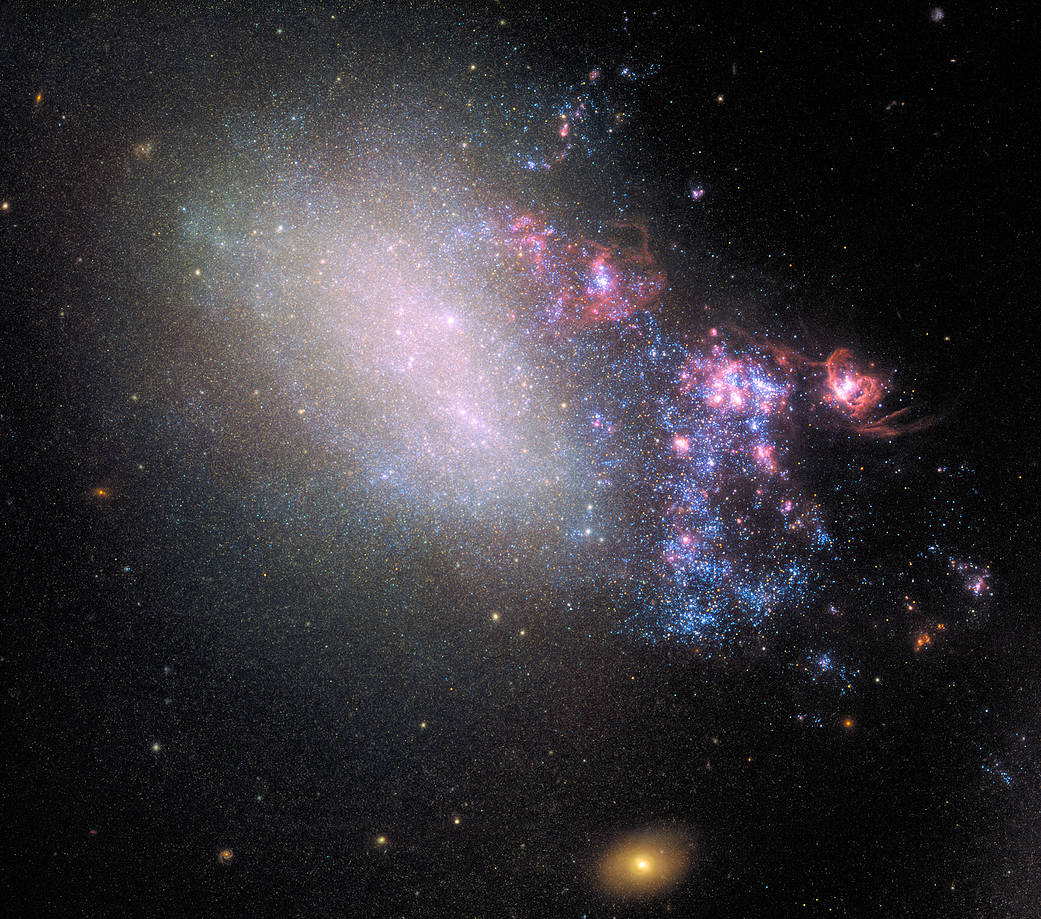不规则星系NGC 4485显示出了它曾与一个绕道而过的星系发生过一起肇事逃逸事故的所有迹象。这次偶遇并没有毁灭银河系,而是孕育了新一代恒星,可能还有行星。
星系的右侧闪耀着恒星形成的光芒,众多年轻的蓝色恒星和正在孕育恒星的粉红色星云中都显示了这一点。然而,左边看起来完好无损。它包含了星系之前螺旋结构的蛛丝马迹,这个螺旋结构曾经经历过正常的星系演化。
更大的罪魁祸首NGC 4490在这幅图的底部。这两个星系在数百万年前擦肩而过,现在相距24000光年。它们之间的引力拉锯战在两个星系中都产生了高密度气体和尘埃的波纹。这一活动引发了一系列恒星的形成。
这个星系是附近宇宙撞车活动的一个例子,这种活动在数十亿年前更为常见,当时宇宙更小,星系距离更近。
NGC4485位于2500万光年之外的北部Canes Venatici星座(猎犬星座)。
这张由哈勃广域相机3号(WFC3)拍摄的新照片,进一步揭示了星系演化的复杂性。
哈勃太空望远镜是美国宇航局和欧洲航天局(ESA)合作的一个国际项目。位于马里兰州格林贝尔特的美国宇航局戈达德太空飞行中心负责管理该望远镜。位于马里兰州巴尔的摩市的太空望远镜科学研究所(STScI)负责哈勃的科学运作。 STScI由华盛顿特区天文研究大学协会为NASA运营。
The irregular galaxy NGC 4485 shows all the signs of having been involved in a hit-and-run accident with a bypassing galaxy. Rather than destroying the galaxy, the chance encounter is spawning a new generation of stars, and presumably planets.
The right side of the galaxy is ablaze with star formation, shown in the plethora of young blue stars and star-incubating pinkish nebulas. The left side, however, looks intact. It contains hints of the galaxy’s previous spiral structure, which, at one time, was undergoing normal galactic evolution.
The larger culprit galaxy, NGC 4490, is off the bottom of the frame. The two galaxies sideswiped each other millions of years ago and are now 24,000 light-years apart. The gravitational tug-of-war between them created rippling patches of higher-density gas and dust within both galaxies. This activity triggered a flurry of star formation.
This galaxy is a nearby example of the kind of cosmic bumper-car activity that was more common billions of years ago when the universe was smaller and galaxies were closer together.
NGC 4485 lies 25 million light-years away in the northern constellation Canes Venatici (the Hunting Dogs).
This new image, captured by Hubble’s Wide Field Camera 3 (WFC3), provides further insight into the complexities of galaxy evolution.
The Hubble Space Telescope is a project of international cooperation between NASA and ESA (European Space Agency). NASA’s Goddard Space Flight Center in Greenbelt, Maryland, manages the telescope. The Space Telescope Science Institute (STScI) in Baltimore, Maryland, conducts Hubble science operations. STScI is operated for NASA by the Association of Universities for Research in Astronomy in Washington, D.C.
Text credit: Space Telescope Science Institute
Image credit: NASA, ESA; acknowledgment: T. Roberts (Durham University, UK), D. Calzetti (University of Massachusetts) and the LEGUS Team, R. Tully (University of Hawaii) and R. Chandar (University of Toledo)







